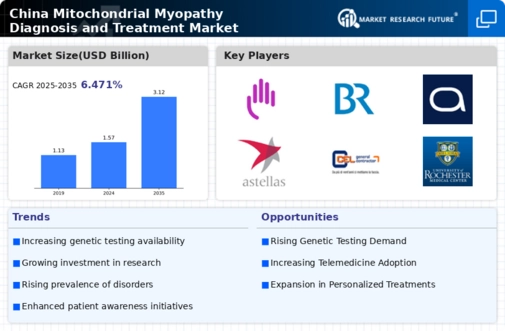Growing Awareness and Education
The increasing awareness and education surrounding mitochondrial myopathy are significant drivers for the mitochondrial myopathy-diagnosis-treatment market. Educational campaigns targeting healthcare professionals and the public are essential for early diagnosis and intervention. As knowledge about mitochondrial disorders expands, more patients are likely to seek medical attention, leading to higher demand for diagnostic services. Furthermore, healthcare providers are becoming more adept at recognizing symptoms associated with mitochondrial myopathy, which may result in earlier and more accurate diagnoses. This heightened awareness is expected to contribute positively to the growth of the mitochondrial myopathy-diagnosis-treatment market in China.
Government Initiatives and Funding
Government support plays a pivotal role in shaping the mitochondrial myopathy-diagnosis-treatment market in China. Recent initiatives aimed at improving healthcare infrastructure and funding for rare diseases have emerged, potentially increasing access to diagnostic and treatment options. The Chinese government has allocated substantial resources to research and development in the field of genetic disorders, which includes mitochondrial diseases. This funding is expected to facilitate the development of innovative therapies and enhance diagnostic capabilities. As a result, the market may experience accelerated growth, driven by enhanced collaboration between public institutions and private entities focused on mitochondrial myopathy.
Rising Investment in Rare Disease Research
The rising investment in rare disease research is a notable driver for the mitochondrial myopathy-diagnosis-treatment market. In recent years, there has been a marked increase in funding from both public and private sectors aimed at understanding and treating rare genetic disorders, including mitochondrial diseases. This influx of investment is likely to accelerate the development of novel therapies and improve diagnostic methods. As research progresses, new treatment options may emerge, enhancing the overall landscape of the mitochondrial myopathy-diagnosis-treatment market. This trend indicates a growing commitment to addressing the unmet needs of patients suffering from mitochondrial myopathy in China.
Technological Advancements in Genetic Testing
Technological advancements in genetic testing are transforming the mitochondrial myopathy-diagnosis-treatment market. Innovations such as next-generation sequencing (NGS) have significantly improved the accuracy and speed of diagnosing mitochondrial disorders. These advancements enable healthcare providers to identify genetic mutations associated with mitochondrial myopathy more efficiently, leading to timely interventions. The market is likely to benefit from the increasing adoption of these advanced diagnostic tools, as they provide more comprehensive insights into patients' conditions. As a result, the mitochondrial myopathy-diagnosis-treatment market may experience growth driven by the demand for precise and rapid diagnostic solutions.
Increasing Prevalence of Mitochondrial Disorders
The rising incidence of mitochondrial disorders in China is a crucial driver for the mitochondrial myopathy-diagnosis-treatment market. Recent estimates suggest that mitochondrial diseases affect approximately 1 in 5,000 individuals, leading to a growing patient population requiring diagnosis and treatment. This increasing prevalence necessitates advancements in diagnostic technologies and therapeutic options, thereby stimulating market growth. As awareness of these disorders expands among healthcare professionals and the general public, the demand for specialized diagnostic services and targeted therapies is likely to rise. Consequently, this trend may lead to increased investments in research and development, further enhancing the mitochondrial myopathy-diagnosis-treatment market in China.

















Leave a Comment